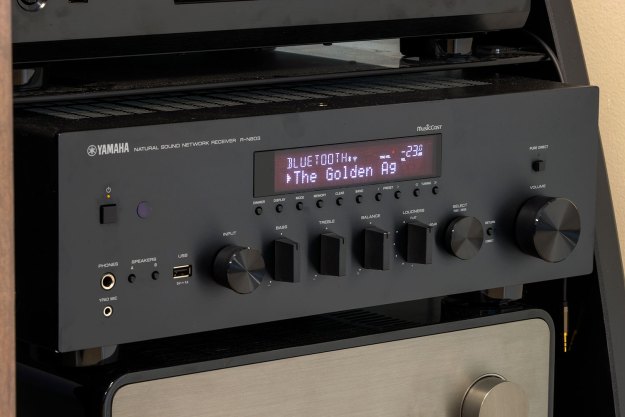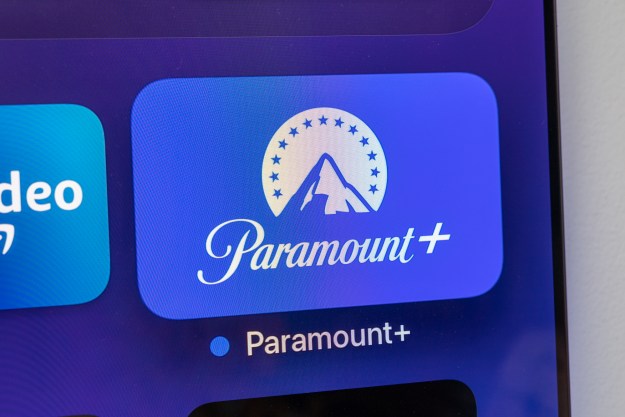
- Vibrant, accurate sound signature
- Easy to set up
- Room tuning software built-in
- Wide array of input options
- Simple aesthetic may not suit everyone
As the world of home audio has recently become the stomping ground of small, smartphone-controlled speakers that can answer your questions about the weather between Spotify playlists, many have speculated that the large, shelf-stealing stereo receivers of yesteryear may soon go the way of the dodo.
At least for high-fidelity users, devices like Yamaha’s R-N803 have us skeptical that the big black box on the living room shelf will ever fully disappear. With a vast array of analog and digital inputs, hi-res streaming, a massive 145 watts-per-channel, and built-in room correction software, the R-N803 is less like the dodo bird and more like the predator that’s chasing older, less capable amplifiers off a cliff. If you are serious about your sound, want 21st century listening convenience, and don’t want to tap into your vacation fund to get it, this is one of the very few devices that will suit your needs.
Out of the box
One place the Yamaha R-N803 looks back rather than forward is in its visual aesthetic. At first glance, the large black unit looks very similar to many other receivers, though Yamaha’s retro design touches were favored by some of us — the slim tone dials and even Yamaha’s font harken back to the company’s ’70s-era receivers.
A small, digital screen at the front of the unit is joined by two round selection knobs, a volume knob, and four tone controls, as well as various small buttons that control everything from the screen’s brightness to radio presets. Also at the front are a USB input, headphone output, and 3.5 mm microphone input for the built-in room correction software. It’s not a box we’d describe as simple or particularly elegant to look at, but the upside is that you can do virtually everything you need to — even advanced set-up — without the remote.
Accessories include the long silver remote, a radio antenna, microphone, and power cable.
Features
With the exception of an HDMI input for home theater use (not really a necessity for a two-channel stereo amp like this one, anyway), the R-N803 has every audio input you could ask for. On the rear of the amp are three basic RCA line inputs (two with outputs), a dedicated CD RCA input, and even a built-in phono stage for fans of turntables or for those looking to start a vinyl collection down the line. There’s also both an optical and coaxial input, a space for AM and FM antennas, and an Ethernet port for wired internet — the receiver also supports Wi-Fi, but we recommend using wired internet for streaming any kind of media when possible. In terms of actual sound output, the amplifier can support two sets of stereo speakers and a single subwoofer.
Network integration sets the R-N803 apart from many of its high-powered peers.
The thing that sets the R-N803 apart from the vast majority of its high-powered peers is its outstanding network integration. Once connected to your home network, the amplifier will stream Spotify, Pandora, Tidal, Sirius XM, Napster, and Deezer via Yamaha’s MusicCast smartphone app. The receiver can also connect with other MusicCast devices for a full multi-room experience. In addition to MusicCast, the amp boasts Airplay for Apple Music connection, and Spotify Connect makes the most popular music streaming service easy to use from the desktop as well. Bluetooth is also included for those who don’t want to use a network, though sound quality will suffer.
Under the hood, there are a lot of tech features that enable the R-N803 to pump out great sound. First and foremost, the box houses a high-end SABRE 9006AS digital to analog converter (DAC), which allows it to support high-resolution audio at 24-bit/192kHz resolution. In addition, the amplifier features a massive power transformer and Yamaha’s “Pure Direct” mode, which allows music signals to bypass the buffer amp and tone controls for the shortest possible circuit route, a feature that should appeal to audiophile purists.
To keep everything sounding crisp and clean, the included microphone integrates with Yamaha’s YPAO (“Yamaha Parametric Room Acoustic Optimizer,” for the acronym nerds), which allows the amplifier to automatically adjust its frequency response based on the room you’re in.
Setup
Setting up the amplifier is as simple as plugging it in, connecting your speakers and source devices, and pairing the system with your network via Ethernet or Wi-Fi. From there, the MusicCast app takes over as your streaming interface with the amp (unless you are using Spotify Connect, Airplay, or Bluetooth).
Performance
We spent the majority of our time testing the R-N803 with a pair of beautiful Klipsch Forte III speakers, but we did also use it to power Bowers and Wilkins’ 702 Series 2 towers, and a set of smaller (but still astonishingly great) Paradigm Persona B bookshelf speakers. No matter what we were listening to or which speakers we were listening to it with, the powerful amplifier offered excellent transparency and a wide soundstage, making it a downright pleasure to listen to.
Being as it is a network amplifier, the majority of our listening time was spent streaming music via either Spotify or Tidal over a wired Ethernet connection, though we did spend a few hours listening to CDs through an Oppo UDP-203 Blu-ray player via the Yamaha’s optical input. Regardless of input, the digital-to-analog conversion offered by the amp was top notch — we could not discern a difference between lossless CD or streaming, and, as usual, the difference between those sources and high quality 320K Spotify was practically negligible in our room, even with such a nice assortment of speakers.
As a brand, Yamaha may not have the same cache among audiophiles as other premium names in the space, but all of the individual components inside the R-N803 combine to offer thoroughbred performance that easily matches more expensive options. We listened to the amp in tandem with the much pricier (and, worth noting, significantly more beautiful to look at) Naim Uniti Atom, and found ourselves hard-pressed to find much that the Yamaha couldn’t do just as well as the Naim. That isn’t to say the Naim is a bad product by any stretch of the imagination, it’s more of a commentary on how amazing the Yamaha sounds for the money.
When listening to floaty jazz like Bill Frisell’s cover of The Beach Boys’ Surfer Girl, the slide guitar floated at the edges of the stereo image, with Frisell’s iconic telecaster tone coming through warm and clear. Separation between instruments is particularly impressive on the Yamaha, and dense percussion-filled mixes like Santana’s Black Magic Woman had the same immediacy and clarity we expect from much more costly stereo hardware.
Speaking of which, though the overall warmth of the solid-state Yamaha wasn’t as round as the Peachtree Nova 225 SE we’ve long used as our high water mark for comparative amplifier testing — an amp that features a tube-based preamp stage and a much higher MSRP — the Yamaha did not leave us wanting. In fact, the combination of the Klipsch Forte III and the plucky Yamaha proved extremely potent when listening to vintage rock like The Rolling Stones’ Gimme Shelter at high volumes, a raucous experience that took full advantage of the amp’s massive power.
Excellent transparency and a wide soundstage make it a downright pleasure to listen to.
In terms of equalization, we tested the YPAO room correction software with both the Klipsch Forte III and Paradigm Persona speakers, and found that after the quick one-minute setup, it did tame some mid and treble issues in an untreated listening space. While the YPAO does well to fine-tune small issues, buyers should know that it won’t take care of physical issues like frequency dead zones.
In every context, the R-N803 proved to be a powerful and receiver that’s fun to listen to and can play virtually anything from any source. Frankly, it’s surprising that so much capability and fidelity is available at such a low price point, and we now consider it one of the sleeper hits of the hi-fi audio world.
Warranty information
Yamaha offers a two year warranty on all defects in materials and workmanship.
Our Take
The Yamaha R-N803 is a play-anything amplifier that will take audio from almost any source, power all but the biggest speakers on the planet, and sound amazing doing it.
Is there a better alternative?
Those in the market for a stereo receiver with network capabilities will have a hard time finding something with the same power per channel as the Yamaha in this price point, but that doesn’t mean there aren’t worthy competitors. The more-affordable Onkyo TX-8270 and Pioneer Elite SX-N30 offer similar form factors and connectivity, but lack some of the bells and whistles offered by YPAO and Yamaha’s MusicCast integration, while the Marantz M-CR611 has fewer inputs, but does include a CD player. Still, for our money, the R-N803 easily stands at the top of the heap.
How long will it last?
Yamaha has a history of making extremely solid and long-lasting products, and the overall build quality of the R-N803 matches this reputation. Provided it is treated with care, this amplifier should last for many years.
Should you buy it?
Yes. The Yamaha R-N803’s wide array of inputs, network connectivity, and excellent sound signature make it a star. Those who are looking for audiophile-grade sound at a relatively low price point should seek out this sleeper hit before spending significantly more money on a potentially prettier — but not necessarily better-sounding — competitor.











